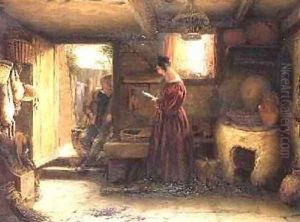William the Younger Mulready Paintings
William Mulready the Younger was an Irish genre painter living and working in England during the 19th century. He was born on April 1, 1786, in Ennis, County Clare, in Ireland. At a young age, Mulready moved to England with his family. He showed an early interest in art and was admitted to the Royal Academy Schools at the age of fourteen after a short period of initial training under the tutelage of the genre painter John Varley.
Mulready quickly established himself as a skilled artist, initially making a name for himself with works that depicted scenes from everyday life, often with a moral or sentimental narrative. His painting style was characterized by its detailed and meticulous approach, with a focus on capturing the textures of fabrics and the subtleties of human expression. He became noted for his genre paintings, which often included children and had a charm that was appealing to Victorian sensibilities.
Throughout his career, Mulready enjoyed considerable success. In 1805, he was elected an Associate of the Royal Academy and became a full Academician in 1816. His reputation was further enhanced by his appointment as a drawing master to Princess Victoria, who later became Queen Victoria. Mulready's work was widely exhibited, and he was commissioned by a variety of patrons, including members of the British aristocracy.
Aside from his paintings, Mulready also gained fame for his designs for the postal service. In 1840, he was commissioned to design the decorative framework for the newly introduced Penny Black and Twopenny Blue postage stamps, which were the world's first adhesive postage stamps. However, his intricate design proved too difficult to reproduce on a small scale, and it was eventually replaced. Nonetheless, his contribution to postal history remains significant.
Throughout his life, Mulready was involved in various aspects of the art world, including teaching at the Royal Academy and contributing to the debate on art education. He was a respected figure in the artistic community and influenced a number of younger artists.
William Mulready the Younger passed away on July 7, 1863, in London. He left behind a legacy of finely crafted genre paintings that provide a window into the social life and customs of 19th century Britain. His work is still appreciated today for its technical skill and its capacity to convey the intimate moments of everyday life.
